I know a reloader who doesn’t trim the length of his rifle cases. He shoots bolt action rifles, doesn’t crimp, shoots only mild to mid-pressure loads, and throws away his cases on the 4th or 5th load. He shoots iron sights only and he doesn’t shoot much. And for him, that works just fine.
For every other reloader out there, case length trimming for your bottleneck rifle cases is an absolute must, and it’s something to pay attention to. Lyman’s new Brass Smith Case Trim Xpress is a great piece of equipment that helps you get that done well, and with a quickness.
For those of you who don’t know what case length trimming is, it’s pretty much right there in the name. When we fire and when we reshape our brass cases in a sizing die, those cases stretch in length.
Because of how sizing dies work, the shape of cases, and the shape of chambers, the vast majority of that extra length remains at the neck, the opening at the top of the case that holds the bullet.
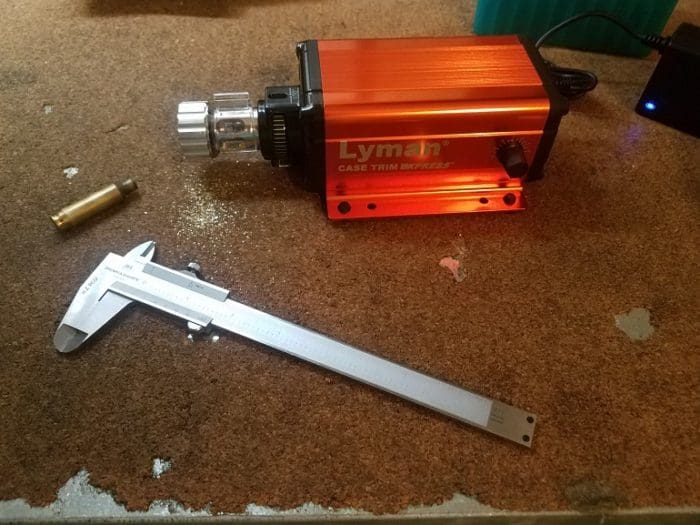
If that neck is too long, all sorts of problems occur. First, and especially in an autoloader like an AR-15 rifle, a neck that is too long will lead to issue with the round consistently chambering. That is both a reliability and a safety concern.
If the case is to be crimped onto a bullet — and for some cartridge and rifle combinations that is an absolute necessity — cases must be of exactly the same length or the location of the crimp will be changed. This will have a significant effect on accuracy between shots, and it could also have real safety concerns.
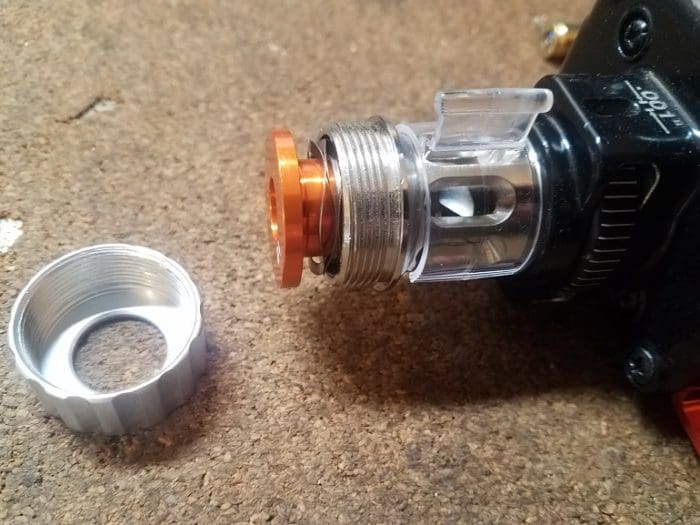
Finally, case length will have a real and noticeable effect on accuracy between shots. Cases of unequal length put unequal pressures on the bullet as it’s held by the case, therefore they release differently when fired. Remember, we are constantly seeking consistency, and case neck length is definitely a place where consistency is critical.
You can achieve that length a bunch of different ways, but the basic process is essentially the same. Size the brass, measure the length, cut new length, measure to verify, and then clean up the edges.
I’ve always used the old fashioned, super-slow manual method of cutting the cases down while they’re held with a case-specific cartridge holder. This process is not only time-consuming since I can do about two cases a minute, but it means I have to purchase a case holder for each parent case, at about $12 to $15 a piece.
Lyman’s new Brass Smith Case Trim Xpress, on the other hand, requires no case holder, no additional accessories, and cuts cases as fast as 15 per minute. This is one of those rare cases (pun intended) where a little bit of technology produces a product just as good as anything that’s done by hand, only a whole lot faster.
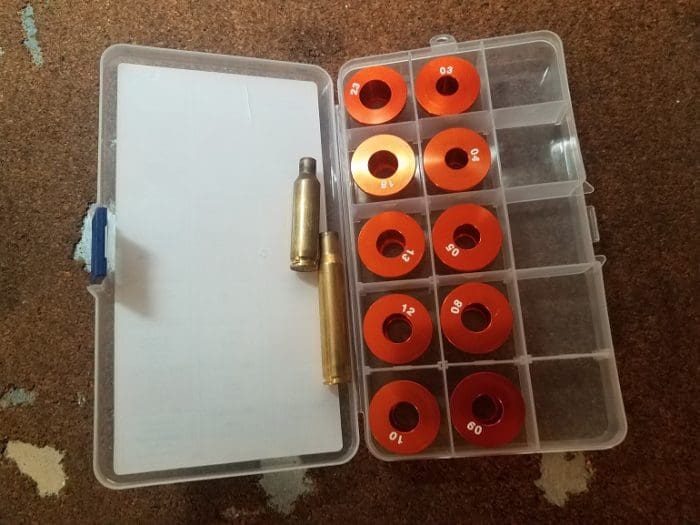
The trimmer itself comes with 10 different bushings that handle most common calibers, but there are a few not in the list. Folks reloading 7.62×39, 6.5 Grendel, .375 H&H Magnum, or .338 Lapua magnum would have to purchase additional bushings. Fortunately, they’re only $9.95 on the Lyman website.
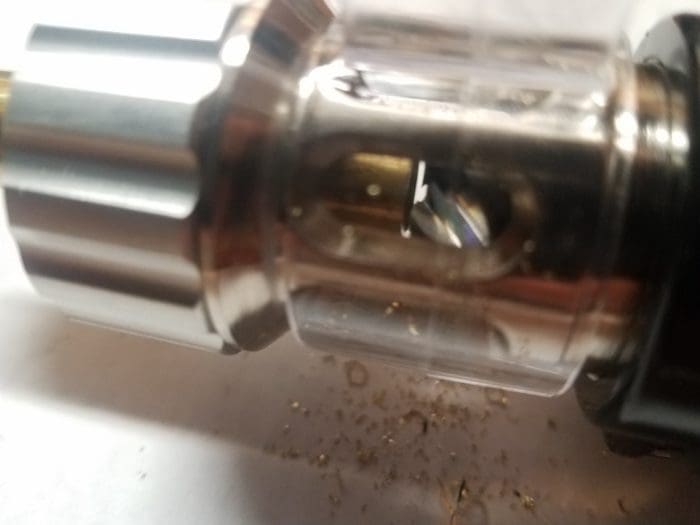
Unlike many other options, no additional drill is needed to run the Case Trim Xpress. It’s all right there in a single two-pound self-contained unit that takes up very little bench space.
That two pounds isn’t heavy, but it’s heavy enough that if you don’t want to permanently mount it to your bench, you can use it unsecured without the cutting mechanism moving around during operation. There is no pilot required, and a single carbide bit does all the cutting.
Set-up of the Case Trim Xpress takes all of about 45 seconds, maybe a minute if you count plugging it in. Always read the directions, but this is about as straight forward as it gets.

There’s a little clear plastic cover over the cutting housing that drops the shavings straight down. You’ll want to put a piece of paper or a small tray under there to catch the shavings, otherwise they’ll get everywhere with a quickness.
The Case Trim Xpress comes with a slick adjustment knob that allows you to dial the depth of the cut down in .001″ increments. After the initial set-up, the user just dials in the desired amount of cut and presses the case into the cutter.
Note that there aren’t individual numbers, just hash marks, each representing .001″ of adjustment. You’ll have to count out each of these marks to get you to the right amount of cut.
There are a few things I know I can trust in the world. Water will be wet. Texas will be hot. And my Browne and Sharpe calipers will read true. I used them to measure the amount of brass the Lyman cutter said it was cutting vs. what it actually cut. It turns out there really is truth in advertising. If you tell the Case Trim Xpress to cut .001″, it cuts .001″.
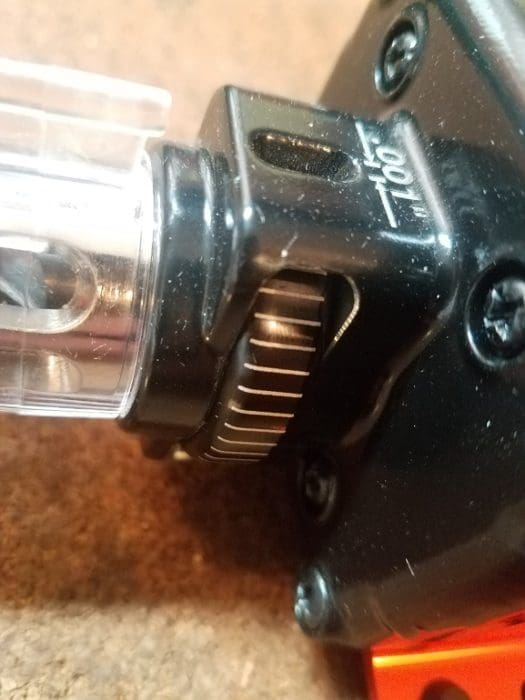
There’s a spring providing back pressure on the bushing while you hold a case in, and there’s no need to press on the case very hard. It doesn’t really matter if you do, other than you’ll have to deal with some chattering if you have a lot to take off.
Even then, it will even out in just a second. If you gently press the sized case into the trimmer, it will index off the shoulder and provide a consistent length cut every single time, and do it in no time.
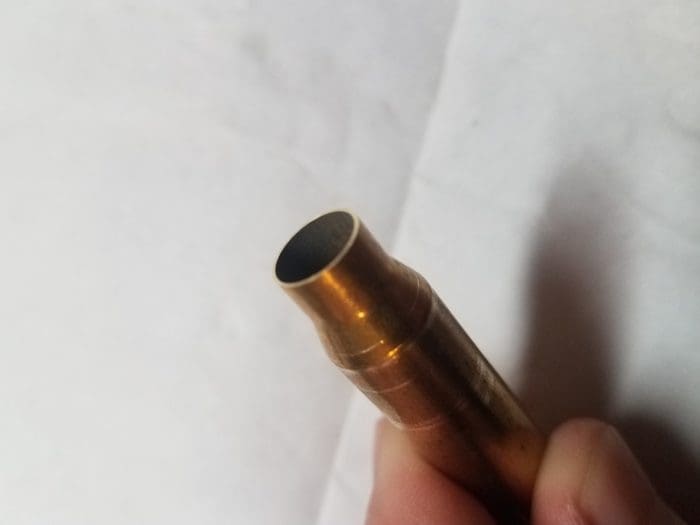
The cut itself comes out square and smooth. I would still recommend using a case chamfering tool and to bevel the edges.
The Case Trim Xpress is a great piece of equipment. It’s small, but just heavy enough. It cuts a neat, precise neck. It saves a fantastic amount of time compared to manual methods. It’s self-contained and requires no hand drill or external motors.
I have a lot of Lyman tools and for good reason. Lyman’s done a great job, again, with the Case Trim Xpress.
Specifications: Lyman Brass Smith Case Trim Xpress
MSRP $164.95
Overall * * * * *
Not cheap, but considering you don’t need a drill for it like many other models, it’s a good value. The features, quality of manufacture, and most importantly, results are all top notch.

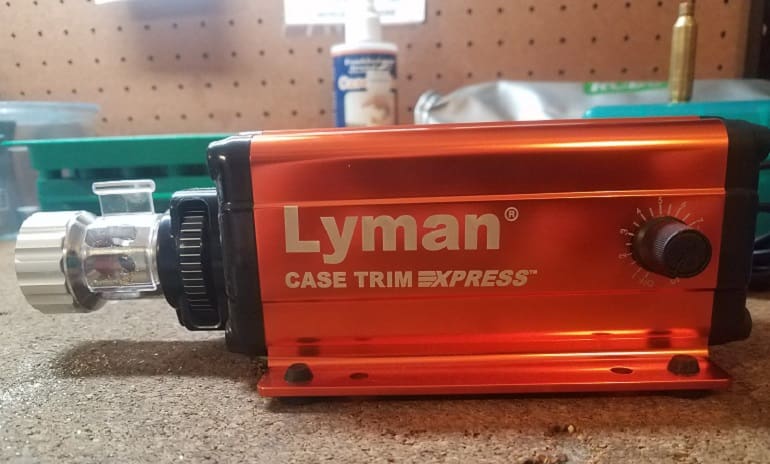



While on this subject, one other concern deserves mention. The stretching of belted magnum cases. Today’s magnums have mostly dispensed with the old belted cases based on the original .375 H&H case(as they should, since it serves little purpose other than to headspace on, if the cartridge in question has too little shoulder to use for that purpose). For example, .300 WIN MAG, .338 WIN MAG, 8mm Remington MAG, all of the Weatherby Magnums, etc. But in today’s sharp shouldered magnums, it serves no useful purpose any longer.
For all of the belted cases, if one sizes them normally, there will be usually be some space at the shoulder, so it doesn’t QUITE touch the shoulder of the chamber. This isn’t a safety issue, since the case is headspacing on the belt instead of on the shoulder, but it does mean that each time a round is fired, the case will stretch forward to take up that space. And belted cases tend to stretch out from the belt area back by the head, which results in a thinning of the case right in front of the belt in the web. This is a bad area to introduce weakness, because it is the area where cases usually separate anyway, thus needs the most strength.
The solution to this is to neck size only on belted cases. If that isn’t an option(like for a Browning BAR in .300 WIN), then carefully adjust the sizing die to not swage the case all the way back down to SAAMI standards, but leave it just slightly long. Adjust the die until the case only just fits into your individual rifle’s chamber.
Now that case will be headspacing on the shoulder, and the belt will be irrelevant. This will result in the brass stretching out in the neck area instead of back in the web(the area right in front of the belt), where the most strength is needed.
Naturally, the cases will all still need to be trimmed to the proper length beforehand, the same as any other, non-belted, case. Here’s hoping this helps somebody.
Happy Reloading
On my 7 mag, I screw my FL sizing die down until it kisses the shell plate and then back it off a half turn and screw it down until I bump the shoulders .001-.003″
You need this to do it.
https://www.hornady.com/reloading/precision-measuring/precision-tools-and-gauges/headspace-comparator-anvil-base-kit#!/
Tyler Kee: If you neck size a fired case so the neck won’t drag in the die, you can screw it down until you feel the shoulder in the die just touch the case’s shoulder. That should put the headspace perfectly on the shoulder, leaving the slight space now back by the belt where it won’t matter.
It’s kind of like getting the feel of using the barrel on a micrometer, if you know what I mean.
Just bought it through the link here, hope this helps you guys when I click it.
The link had it discounted $30 on Amazon so it was a bit cheaper.
I started trimming my brass with Lee case trimmer, then I moved to Lee Deluxe Power Quick Trim Case Trimmer, but it was still too slow and labor intensive. Last year I researched all available case trimming options trying to find something that would allow me to process hundreds of cases at a time but not cost an arm and leg. If this trimmer was available then, I would have strongly considered it.
Giraud Power Case Trimmer also looked great, but it is a bit pricey. Finally I decided to go with WFT second generation from Little Crow gunworks. It requires a drill to power it, but I have several of those. It doesn’t have micrometric adjustments, you need a trimmed case to set the cutter. But once it’s set it is very fast and easy to use. When the supplied steel bit became a little dull I bought a carbide one that creates very nice and smooth cut without any burrs. Bushings for different case sizes are about $25.
I use an RCBS Power Trim Pro. Bit of a bulky setup, but you can cycle it pretty fast.
Not quite as nice as my Giraud. But a heck of a lot cheaper.
I like Browne and Sharpe, they are a close second to Mitutoyo. Starrett 120A’s have gone down in quality lately, but old ones usually are still dead nuts even after a decade or two. As long as they are taken care of!
A gauge block or two is still handy to double check them every now and then however.
The newest set of Brown and Sharpe calipers I own are about 50 years old.
This set up looks a lot more simple than the old Lyman Power Trimmer I’ve been using for 25 years. (A lot less bench space as well.) I also use a Forster hand crank model occasionally and to turn necks. I don’t think the price of the unit described is expensive at all, next on my purchase list. Thanks for the review.
I’m neck turning by hand as well, but that’s about to change. I just picked up a 6mmSLR that shoots a real 1/4 MOA. Unfortunately, despite what folks in the internet assured me, I’m going to have to neck turn every piece of 243Win brass that goes into the gun. I’m not doing 500 pieces by hand.
If anyone has a recommendation on equipment to use there, I’d appreciate it.
DJ’s Brass Service
https://djsbrass.com/
…the best neck turning tool on the planet
Comments are closed.